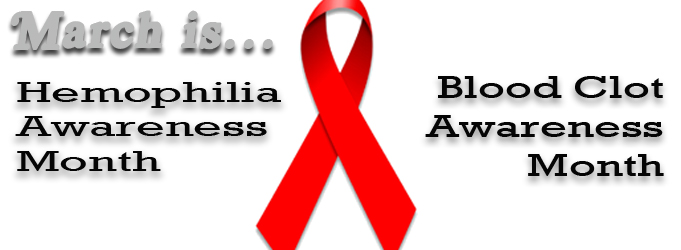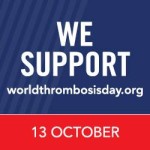
March Awareness Month Quick Facts
March 3, 2014; Posted by: WeBleed staff
March 2014 is national awareness month for both blood clots and hemophilia.
Have you ever heard of a blood clot? How about a bleeding disorder? Does deep vein thrombosis or Factor V Leiden sound familiar? How about hemophilia, or factor 8 or 9 deficiency? If you have not, March is the month to study up! Both bleeding and clotting disorders have a rich history. Some are genetic. Some are acquired. Both are important enough to have a whole month designated to a deeper understanding of what each disorder truly is.
BLOOD CLOTS
Let’s begin with blood clots. Who better to look to for information than the National Blood Clot Alliance (NBCA) when it comes to clots. Blood clots affect anyone from babies to teenagers to adults. There is no one gender or race that is not affected by some kind of blood clotting disorder. A blood clot is diagnosed every minute and are the #1 killer of new mothers in childbirth. According to the NBCA, one person dies from a blood clot every 6 minutes.
The good news about blood clots is that they can be prevented. Through increased efforts in pharmaceuticals and new guidelines in preventing clots the morbidity level decreases drastically. By moving around, living healthy, knowing the signs and being smart with medications will save you both time and money (hospital visits) in the long run as well as your quality of life. March may be one awareness month for blood clots but staying aware of clots should continue to be an ever month occasion.
HEMOPHILIA (A,B,C)
Now let’s talk about hemophilia. Here are the fast facts according to the National Hemophilia Foundation:
- Over 18,000 people in the United States have some type of hemophilia. Worldwide, that number increases drastically with no certain total.
- Hemophilia is genetic but can also be acquired.
- A man with hemophilia cannot pass it to any of his children. However his daughters can carry the gene.
- The cost of medication for hemophilia is very expensive ranging anywhere from $50,000 – $200,000 annually.
- Currently, hemophilia is a life-long chronic condition with no cure.
In 1986, Ronald Reagan designated the month of March as Hemophilia Awareness Month to bring awareness and attention to those living with a bleeding disorder according to the Hemophilia Federation of America. Every year, much like blood clots, the month of March is looked upon as a time to spread the word and advocate for this factor deficiency. However rare of a disorder, the strength in numbers of people willing to advocate for hemophilia in the bleeding disorders community is tremendous. From archery and clay-shooting fundraisers, to local walks, beer feasts, golf outings and trivia nights, organizations across the United States look upon March as a month to celebrate the rich history of hemophilia and a time to show support for bleeding disorders.
Click here for the official proclamation (1986) from President Ronald Reagan.
Due to the many social outlets to spread the word about both bleeding and clotting disorders, March should be full of take-home information to share with family, friends and co-workers. Remember when you post on Facebook or tweet on Twitter, you are not only supporting your own diagnosis or experience with bleeding and clotting disorders – but also everyone who has had a clot or a bleed or knows someone who has, or may know someone in the future.
webleed.org – your source for bleeding news!



